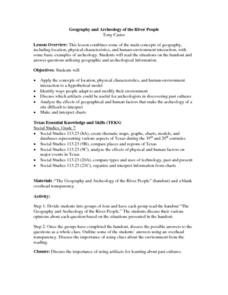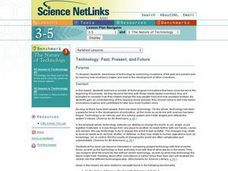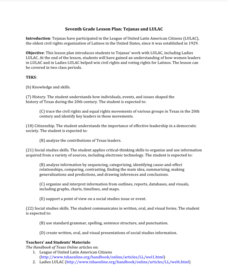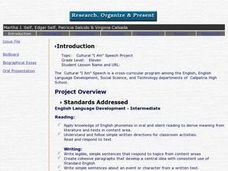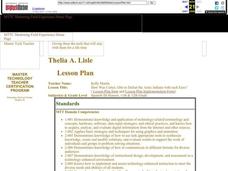Curated OER
People of the Past
Students investigate the four groups of people that existed in the U.S. before the European settlers arrived. They predict how the people arrived in the U.S., then investigate their predictions to find out whether or not they are...
Curated OER
Geography and Archeology of the River People
Seventh graders work together in groups to read a handout and answer questions about the geography and archeology of a group of native peoples. As a class, they discuss their opinions and answers and the importance of using artifacts to...
Polar Trec
Do Microorganisms Live in Antarctica?
Can microorganisms live in the dry, cold climate of Antarctica? Young scientists view a research project measuring microorganisms in the Taylor Glacier. They record the findings from dirty ice, clean ice, boots, sediment, and more. Then...
Curated OER
Discovering Prehistoric People of Wisconsin
Students list the characteristics of the four main groups of prehistoric people of Wisconsin. They compare the characteristics of the groups of to determine the chronological order of existence in Wisconsin.
Curated OER
Technology: Past, Present, and Future
Students examine inventions of the past and present and explore how inventions inspire and lead to the development of other inventions.
Curated OER
My Hero Learning Circle
Learners participate in a collaboration activity. For this My Hero Project lesson, students discover what a hero is to someone halfway around the world and themselves. Over the 16-week session, circles, made up of between 6-9 classes...
Curated OER
Creating a Hyperstudio Slide Show
Students create a HyperStudio slide show. For this technology lesson, students take the report on a hero that they had previously written. They use HyperStudio to create a multimedia slide show to present to their peers.
Curated OER
Television Goes Digital
Learners explore the difference between analog and digital televisions. They examine how the technology works and the impact of television through history. They also compare older television sets to ones found today.
Curated OER
The European Union
Students compare the structures and content of the United States Constitution against the draft of the European Union Constitution. They consider various perspectives on the formation of a constitution.
Curated OER
A Study of Genocide and Project for Rememberance
Tenth graders examine the mass execution of Ukranian Jews by the Nazis at Babi Yar through a variety of sources, including: music, poetry, primary sources and photographs. They also design a memorial for the victims.
Curated OER
Building the CPR
Tenth graders identify and clarify a problem, an issue, or an inquiry.They plan and conduct library and community research using primary and secondary print and non-print sources, including electronic sources. Students generate and...
Curated OER
Lesson Plans Across the Curriculum
Reviewed resources in this educational search engine include these subjects: science, languages, technology, and multicultural. Various languages are available for the browser.
Curated OER
Using the Internet - Art and Design
An interesting resource that might work best in an upper level art course, this handout provides a list of nine websites where young artists can read and study about all forms of art. These online resources range from a dictionary of...
Texas State Historical Association
Tejanas and LULAC
Seventh graders explore the Latino Civil Rights Movement. In this civil rights lesson plan, 7th graders discover the role of the League of United Latin Citizens (LULAC) as well as the women's arm of the organization and write essays that...
Curated OER
Anasazi/Mesoamerican/Andean: Time and Cultural Passages
Seventh graders role play the position of someone in one of six different civilization groups. They research the group's development, advancement and fall of their civilization. They create a presentation to share the information with...
Curated OER
Cultural Anthropology Study Using the Fundamentals of Geography and GPS
Students, in groups, operate the GPS unit, plotting each head stone with accompanying description. Two other students to log in data that corresponds to the given points. One student to note general observations
Curated OER
Cultural "I Amm" Speech Project
Eleventh graders use the internet and other sources to research a selected individual. They explore important events, challenges, and the impact and influence the person had on US History. Using the information gathered, 11th graders...
Curated OER
Lessons for Atlatl Users with Some Experience-Grade 5
Fifth graders throw darts, collecting data for distance traveled. In this data analysis lesson, 5th graders throw a dart using an atlatl. They calculate the speed for each throw and determine the best dart length for distance throws.
Curated OER
About the U.S.A.
Students research the United States and discover its different climate zones, geographical features, animal life, and various cultures. Students complete a research chart using books, encyclopedias and the internet and present their...
Curated OER
How Cortez Defeated the Aztecs
Learners explore the cultural aspects of the Aztec Indians and their beliefs and knowledge base at the time of Cortez's invasion. They explore how their beliefs impacted the results of Cortez's invasion. Students synthesize information...
Curated OER
Storytelling: Using the Arts to Enrich the Curriculum...
Young scholars explore the art of storytelling and stories from various cultures. Students experience Japanese and Chinese culture as well as Greek mythology. Young scholars create and present their own Greek mythology topic to the class.
Curated OER
Mesopotamia
Sixth graders find information on three culture universals which they choose for their research. They organize their notes and select illustrations to be used in the final report.
Curated OER
How Foods Bonds Our Diverse Background
Pupils have a better understanding of how food choices reflect our cultural background. They reduce a recipe to the correct serving size.
Curated OER
Everyone Eats Bread
Learners identify similarties and differences between different countries and what type of bread they eat. They examine the different cultures of countries by emailing people in other countries. They also locate the country on the map.

